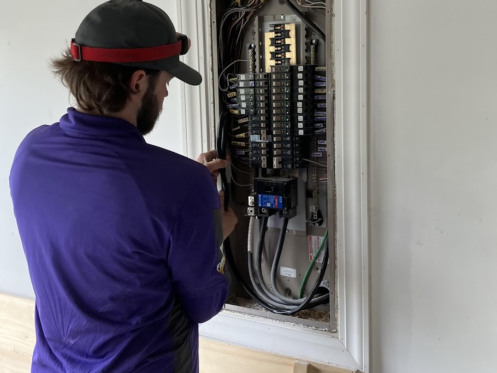For those who work from home, having a reliable internet connection is essential. However, many remote workers don’t consider what can happen to their work environment if an electrical surge damages their computer, printer, internet router and other essential electronics needed for productive work.
You probably have one or more power strips in your home office and in other areas of your home with electronic devices. Some power strips offer basic protection for multiple devices. Yet, these devices vary in quality. You may think your electronics have protection, but that’s seldom the case, as many are glorified extension cords. Excessive power surges will follow any wire into your home, affecting phone and cable lines to threaten computers, modems, fax and answering machines, monitors, and televisions. Virtually any appliance plugged into an outlet can suffer damage or become completely unusable. The damage can run into tens of thousands of dollars, leaving you unable to work from home. A better solution involves having an experienced electrician install whole-home surge protection.
What Is Whole-Home Surge Protection?
Whole-home surge protection senses voltage irregularities in electricity delivery to the main electrical panel, isolates it and diverts the excess voltage into the ground. This action prevents the high current from flowing into your electrical circuit and your appliances and electronics. A grounding wire and rod outside your home disperse the current into the ground. Surges usually only last less than a second, but the strength of the surge can damage your home and trigger numerous faults within its electrical circuits. Electrical surges fall into two main types: internal and external. Here is what you need to know about each type.
Internal Electrical Surges
Electrical power surges occur more often than most people think. Usually, they are small events that go unnoticed by homeowners. However, the damage from these frequent events builds up over time. Internal surges usually result from overloading a circuit. These occur when you plug too many devices or appliances into a single outlet, causing the circuit to attempt to draw more power than it can supply. Faulty or malfunctioning appliances or electrical shorts can also cause an internal power surge.
Appliances and electronic devices that draw a large amount of power when starting can also cause an internal power surge. These include air conditioners, computers, televisions and other similar appliances. Typically, your home’s electrical system will shield against potential internal power surges by automatically tripping a circuit breaker. This action instantly disconnects electricity to an area to prevent your wiring from overheating or damaging appliances.
Electrical panels can also become overloaded and cause an internal surge. In these instances, the main circuit breaker will trip, shutting off your home’s power.
Appliances or devices that require a lot of power, such as air conditioners and refrigerators, can also cause spikes in electricity, along with damaged or exposed wires.
External Power Surges
External power surges occur less frequently but are usually more massive. When they enter your home, they can cause incredible damage to appliances and electronics. Electricity follows any type of wire, including telephone and cable lines. An external power surge can damage devices, appliances and outlets, and they may even start an electrical fire if your home wiring is faulty.
Lightning-induced surges are the most powerful. If a 200,000-amp lightning strike hits any home in your area less than a mile away, it can cause a surge to crash through a power line with the power to burn a standard 20-amp wiring like a lightbulb filament. Lightning strikes are the most common cause of external power surges.
Problems with the local electrical grid can also cause external power surges. Other common causes of external power surges are those caused by downed power lines and sudden changes in electricity use by a nearby factory or another building using high levels of electricity. The damage inflicted by these power fluctuations can be instantaneous but may not show up for some time.
Types of Surge Protection Devices
The most common devices utilize metal oxide varistors to protect your electric system. These are the most common power surge protection devices because they are the most affordable. A semi-conductor prompts the surge protector to act when it detects a current above a specified rating. An electrician can install Type 1 surge protection in the area outside your home near the electrical panel to protect your entire system. However, these are only effective against external surges.
What if I Only Want to Protect My Home Office?
If you have a large home, a whole-home surge protector can become costly. However, you have another alternative. Finch Home Solutions Handle Your Electrical Needs
Our electricians are your Twin Cities-area residential electrical specialists. We offer a range of electrical services, including whole-home rewiring, service upgrades, electric vehicle charging stations, lighting and outlet upgrades, smoke alarm installation and many other tasks. We also provide 24/7 emergency service. Contact our office to schedule your appointment.




